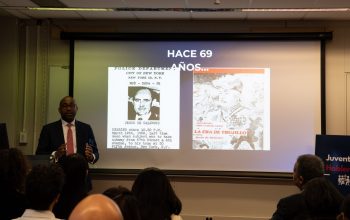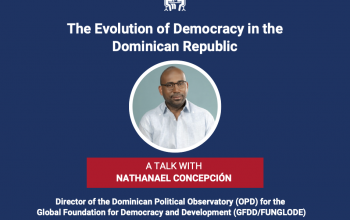news
“The United States: Between the Electoral College and the Popular Vote”, an article by Dr. Leonel Fernández
November 21, 2016
In the recent US presidential elections the candidate from the Democratic Party, Hillary Clinton, won 1,312,000 more votes than her opponent from the Republican Party, Donald Trump.
This is derived from the final calculation of the electoral contest – in which the Democratic candidate received 62,523,126 votes and the Republican 61,201,031.
In percentage terms this means that Hillary Clinton garnered the support of 48 percent of
the electorate, compared to Donald Trump’s 47 percent. In any place in the world where a truly democratic electoral system exists, where one citizen equals one vote, Hillary Clinton undoubtedly would have been deemed the candidate chosen by the most voters.
But that’s not how it works in the United States. In that huge North American country, the winner was deemed to be Donald Trump, due to the use of a strange system to elect the president where the
chosen candidate is not the one who garners the most votes from his or her compatriots but the one who gets the most delegates in the Electoral College.
Paradoxically, just four years ago when Barack Obama was reelected in 2012, Donald Trump tweeted that the Electoral College was “a disaster for a democracy.”
Now that he is benefitting from this electoral mechanism, though, he has dubbed it “actually genius in that it
brings all states, including the smaller ones, into play.”
The Electoral College
The Electoral College is made up of the two senators for each of the 50 states in the nation, whether large or small, plus the number of each state’s members in the House of Representatives, which are currently apportioned at one for every 711,000 residents.
This means that a huge state like California gets 55 Electoral
College delegates, equivalent to the sum of its two senators and its 53 members of the House of Representatives. Texas has 39 and New York and Florida 29 each.
The full number of Electoral College delegates is 538. Winning the United States presidency requires a minimum of 270 delegates. In the recent elections Trump won 290 compared to Hillary Clinton’s 232.
The idea for the creation of the Electoral College system came during the 1787
Constitutional Convention, where a call was made to have the US Congress be the body that chose the president of the United States.
Some delegates to the Convention opposed the selection of the executive power by Congress and expressed a preference for the popular vote to elect the president.
Nonetheless, this wasn’t able to win approval. The delegates from small states thought that a popular vote would give larger states, with their greater
populations, control over the elections, which to them seemed undemocratic.
Hence the delegates had to arrive at an agreement to create a mixed system. By virtue of this agreement the president of the United States would be chosen indirectly by the Electoral College, as delineated in the Constitution.
The functioning of this indirect mechanism for electing the US president is so odd that even most US voters don’t know how it actually
works.
Nearly all of them believe that when they exercise their right to vote they are actually voting for their candidate of their choice.
Actually, they aren’t. They are in fact voting for a set of delegates chosen for each state by the contending political parties. The delegates’ names don’t even appear on the ballot.
The delegates from the winning party later get together in their respective states
and then definitively vote for the candidate who won the most votes in their state’s polls.
For the latest electoral contest, for example, the meeting of delegates from each of the 50 states will occur on December 19, where each will cast his or her vote for Donald Trump or Hillary Clinton in line with the results of each state’s vote.
Later, in a joint session of the House and Senate on January 6, the delegates’ votes will
be counted, and the new president of the United States sworn in on January 20.
An Anachronistic System
To many people, the Electoral College system constitutes an archaic, anachronistic, and anti-democratic mechanism for selecting the president of the United States.
Over the two centuries since its establishment in the US Constitution, more than 700 proposals have appeared to either reform it or get rid of it
entirely.
According to the American Bar Association, there have been more bills and reform projects in relation to the Electoral College than to any other constitutional issue.
This election in which Trump faced off against Hillary Clinton marks the fifth time in US history when a candidate who has lost the popular vote has still achieved victory.
It first happened in 1824, when John Quincy Adams lost both the popular and Electoral
College votes but was proclaimed the victor by the House of Representatives to the detriment of Andrew Jackson’s candidacy (though Jackson nonetheless won the next election in 1828).
Later, in 1876 – in a contest that still draws the interest of historians – the Republican Party candidate, Rutherford B. Hayes, was declared the winner, despite getting fewer votes than the Democrat Samuel Tilden.
The third case took place in 1888, when
president Glover Cleveland could not be reelected despite having won more votes than his Republican counterpart, the Indiana Senator Benjamin Harris.
The fourth case was more recent. It happened in 2000, when Al Gore, from the Democratic Party, won some 500,000 more votes than his Republican opponent, George W. Bush, who was declared the winner after walking away with more Electoral College votes.
These five cases throughout history, with two of them
occurring during the past 16 years, should be enough reason for the Electoral College system to be modified or completely abolished.
Furthermore, in the different elections over the years, between 70 and 85 percent of those surveyed have consistently expressed their support for its elimination.
In the year 2000, after the defeat of Al Gore, Hillary Clinton, then a recent addition to the US Senate, discussed the need for a constitutional amendment to get
rid of the Electoral College system – this because, according to her, the only legitimate way to access power under a democratic system is on the basis of winning a majority of the popular vote. Still, nothing was done. Now, as a result of the latest election, some voices have reappeared to claim that it’s high time for the United States to start electing its president by majority vote, and not on the basis of an outdated legalistic institution like the Electoral
College.
Some add that the moral imperative of its dissolution is even greater when taking into account that behind its inclusion in the Constitution at the end of the 18th century lay the institution of slavery, whereby the total population for purposes of representation was calculated with the value of a black slave set at three-fifths the value of a free man.
Nothing justifies the continuation of the Electoral College in the United States. With such
an atrocious racial background, the most powerful nation on the planet in the 21st century requires an electoral system that is democratic, direct, and popular – a system that can safeguard the unbreakable will of the people of the United States of America.
Related Link:
http://leonelfernandez.com/articulos/






